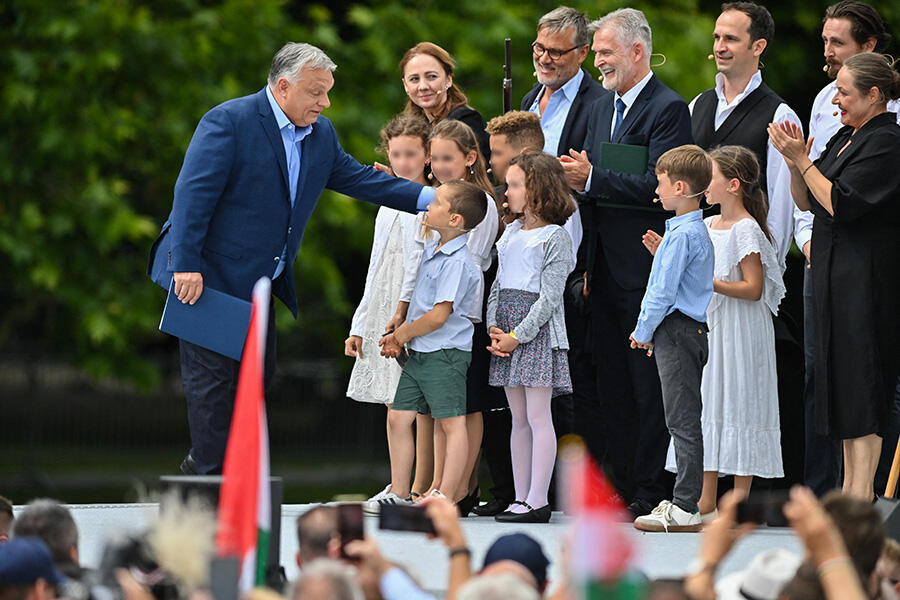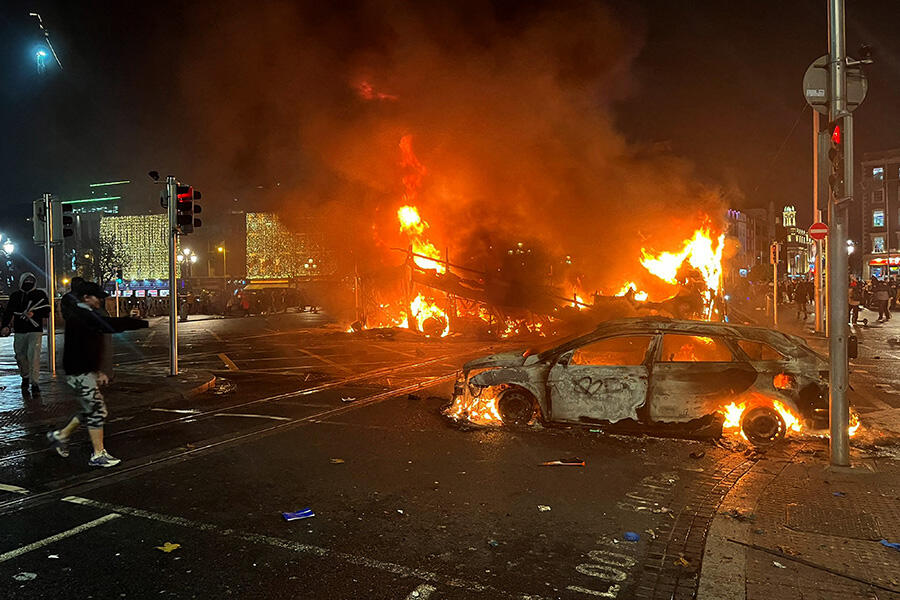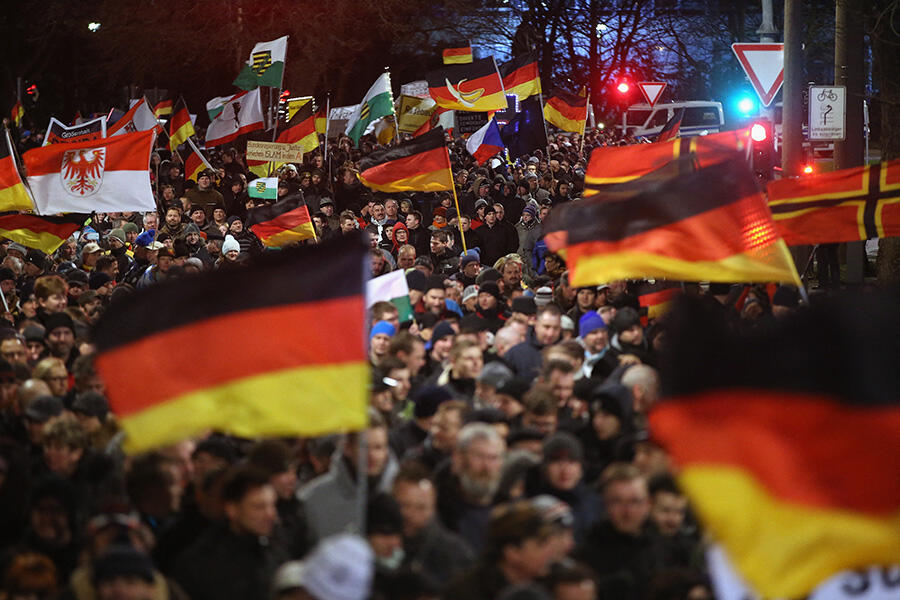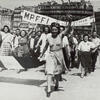You are here
Screening 20 years of far right activism in Europe

The FARPO project relies on data compiled by several projects funded by the Center for Research on Extremism (C-REX), the European Union’s Horizon 2020 research and innovation programme, the Marie Skłodowska-Curie grant N°883620, and the FNSP national political science foundation. FARPO draws on two different datasets: the first (FARPE), 2008-2018, offers a map of the actions conducted by a sampling of far right forces in 12 countries (Austria, Bulgaria, Estonia, France, Germany, Greece, Hungary, Italy, Poland, Slovakia, Sweden, United Kingdom). The second (CFP), 2008-2021, expands the analysis to include all far right groups in 14 countries (Austria, Belgium, France, Georgia, Germany, Greece, Italy, the Netherlands, Norway, Poland, Slovakia, Spain, Sweden, Ukraine).
For more information: https://farpo.eu
What do the various far right parties in Europe have in common?
Caterina Froio1 and Pietro Castelli Gattinara2: Comparative research reveals that historically, these parties share a worldview that combines nativism, authoritarianism and populism. This ideology is that of movements ranging from Vox in Spain to the PIS (Prawo i Sprawiedliwość, Law and Justice) in Poland, the RN (Rassemblement National, National Rally) in France, AfD (Alternative für Deutschland, Alternative for Germany), PVV (Partij voor de Vrijheid, Party for Freedom) in the Netherlands, etc. ‘Nativism’, a blend of nationalism and xenophobia, is the central ideological principle for all of these groups, primarily associated with prejudices and hostility towards immigrants. The nativist attitude embodies a desire to protect against all external threats, especially from immigration, a supposedly homogeneous community in terms of ethnic, religious and/or cultural factors.
The second common point is authoritarianism, characterised by respect for public order through repressive policies and insistence on compliance with established traditions and hierarchies. The third characteristic common to the ideologies of these various far right parties is populism, based on a dual, Manichaean vision of society, opposing a populace represented as ‘virtuous’ against elites who are considered insular and ‘corrupt’, thus affirming the primacy of the unfettered sovereignty of the people.

Lastly, over the past ten years, their rhetoric has also been characterised by a clear opposition to what they derisively call ‘wokism’3, a line of thinking that targets the injustices and discrimination suffered by ethnic, sexual and religious minorities. The far right denounces this as a ‘foreign ideology’, in contrast to the purported values of the national community as well as the traditional visions of the family, gender and the role of religion in society.
Do they all follow the rules of the democratic ‘game’?
C. F. and P. C. G.: Not necessarily. Specialists in comparative politics make a distinction between parties that belong to the ‘populist radical right’, which criticise representational democracy and oppose minority rights but do not seek to overthrow the democratic constitutional order, (at least not openly) and ‘extreme right’ parties that aim to replace democracy with a totalitarian order, without ruling out the use of violence – state or insurrectional – before or after the seizure of power. In the former group, examples would include the RN in France, the Fratelli d’Italia and the Sweden Democrats (SD), while the latter category includes organisations like Golden Dawn in Greece and Marian Kotleba’s ‘Our Slovakia’ party.



However, this distinction is beginning to lose its relevance, because there is more and more hybridisation between the radical right, the extreme right and, in some countries, the traditional right. Researchers therefore prefer to use the term ‘far right’. A good example of this hybridisation is Donald Trump, who did not hesitate to challenge the result of a US democratic election by supporting the attack on the Capitol in Washington, D.C. in January 2021.
In Europe, the Hungarian Prime Minister Viktor Orban has transformed the liberal-conservative Fidesz party into an openly nativist party, as evidenced by its leader’s statement, “We are not a mixed race… and we do not want to become a ‘mixed race’… one that would mix with non-Europeans.”4
It is also important to consider the many extra-parliamentary movements within the extreme right, which do not participate in elections and sometimes use violence to make themselves heard. In Ireland, in November 2023, following a knife attack wrongly attributed to a foreigner, unprecedented riots broke out in the centre of Dublin. Several hundred people set fire to vehicles, looted shops and chanted anti-immigrant hate speech slogans, which also denounced housing allocations for strangers in the context of a severe housing crisis. In Greece, migrants are regularly the target of physical attacks. Some of these movements can gradually evolve to become part of the electoral competition, as has been the case with the Northern League in Italy and the National Front in France, or more recently the Sweden Democrats and the Conservative People’s Party of Estonia (EKRE).
The far right thus unites diverse groups who share an aspiration for a culturally homogeneous society. This worldview has become increasingly evident since the attacks of September 11, 2001 in New York and 2015 in France, when the debate in the European political arena definitively refocused on so-called ‘cultural’ issues, in particular immigration, asylum and Islam. In far right rhetoric, these attacks have been interpreted as signs of an alleged global confrontation between Islam and the West, which has allowed some organisations to reposition themselves as defenders of liberal democracy. This implies adopting a façade of liberalism to stigmatise Muslims and other immigrant minorities as a threat to the values of liberal democracy, women’s rights and secularism.
You have created a database on the far right. Why, and what kind of information does it contain?
C. F. and P. C. G.: The goal is to provide researchers with open-access data to explore fundamental questions in the humanities and social sciences. Studying the extra-parliamentary mobilisations of the far right helps us understand how these groups take root in civil society and participate in the restructuring of the political conflicts and debate.
Until now, studies of the extreme right have mainly focused on electoral performance and ideology, and profiling their membership. But today, extra-parliamentary far right activism is stronger and more visible than ever. For example, on 12 January, 2015, Dresden was the scene of an unprecedented rally that drew 25,000 people, organised by the Patriotische Europäer gegen die Islamisierung des Abendlandes (Patriotic Europeans Against the Islamisation of the West, or Pegida), calling for stricter immigration laws. But these protests go beyond the issues of immigration and Islamophobia, also opposing LGBTQI+ rights and abortion. This was the case in Poland in 2017, and in the Netherlands starting in 2020 with the Vizier op Links (Aim for the Left) campaign targeting academics, to name only two examples of the new extra-electoral terrains of far-right activism.

It is becoming increasingly evident that the extreme right is now an opinion movement that seeks to impose a regressive hegemonic political line. This is reflected in the gradual reorientation of public debates on multiculturalism, citizenship and civil rights, as well as science and academic freedom of expression.
Our hypothesis is that, in parallel with electoral mobilisation, the extra-parliamentary activism of less institutionalised political parties and movements helps establish the far right as an opinion movement. To gain a clear overview of these mobilisations on a comparative scale over time, we have analysed ‘protest events’, in other words collective and public demonstrations organised by these forces to express criticism or disagreement, or to voice demands by non-institutional means.
We needed 17 research assistants and several years of work to integrate into the database all the events that took place between 2008 and 2021 in different European countries, including Georgia and Ukraine. This data was gathered from two main sources: major newspapers in each country (for example, Le Figaro and Le Monde for France) and the websites of the far-right groups themselves. All of this information is now available to everyone on the FARPO website.
The compilation of this data has enabled the visualisation of very different networks of political forces, such as between France and Italy…
C. F. and P. C. G.: The data makes it possible to visualise not only events initiated by far right parties and movements (like those organised by Pegida in Dresden every week for months at a time since 2014), but also those planned by other groups in which the extreme right participates, whether invited or not, as was the case during the ‘yellow vests’ protests in France, which is why those demonstrations appear in the diagram shown below.

Figure 1 shows that extra-parliamentary activism in France is dominated by non-institutional forces, with a strict separation between political parties and protest groups. Among the events in the database, 60% involved movements only, 19% political parties and 20% both types of forces. In addition, only 1% of the demonstrations were organised jointly by political parties and non-institutional groups. In short, France shows a significant discontinuity, or compartmentalisation, between the institutional and extra-parliamentary far right. Although certain grassroots activists sometimes take on official roles in the FN/RN or appear on its ballots (such as Philippe Vardon of the Identitaires), the two worlds remain mostly separate.
It is also clear that the RN is distinct from the various anti-establishment groups and movements. This is due to Marine Le Pen’s strategy of normalising her party by trying to distance it from the most seditious factions. Lastly, there is a transnational effect, even though an analysis of the data does not allow us to determine whether it’s from European movements participating in demonstrations organised by the French far right or vice versa.

Italy is one of the European countries (along with Germany) with the most frequent far right protest events. The Italian network (Figure 2) has a totally different configuration from the French system. The movements and parties are much more closely interlinked, in a structure comprising at least four nuclei corresponding to highly institutionalised parties (Fratelli d’Italia, the Lega) as well as extremely radical protest groups (Forza Nuova, CasaPound Italia).
Even though the far right is in power in Italy, the street protests continue...
C. F. and P. C. G.: Yes, this situation, which can also be observed in Germany, shows that, contrary to popular belief, extra-parliamentary activism does not wane simply because a far right party has achieved ‘good’ electoral results. On the contrary, in both Italy and Germany, institutional and extra-institutional activism seem to reinforce each other. In Germany we’re seeing close collaboration between the AfD party and Pegida. Our analyses show that individuals close to the AfD are participating in demonstrations and other initiatives against immigration and asylum policies. And the links between movements and parties can have significant consequences: in fact, the connections between Pegida and certain key figures of the AfD, developed during the ‘refugee crisis’, have contributed to the hardening of the party’s line on immigration. In a number of countries, the boundaries between the far right’s institutional politics and extra-parliamentary activism are becoming more and more porous.
Which countries have the most protests?
C. F. and P. C. G.: All countries are fertile ground for extra-parliamentary far right activism. But out of a total of nearly 5,000 events recorded in the CFP database between 2008 and 2021, Germany and Italy had by far the most, with 1,450 and 822 demonstrations respectively, compared with 350 in France, 252 in Poland and 172 in Belgium, for example.

What’s the reason for this phenomenon in Italy, where the far right exerts the strongest presence both in the ballot box and in the streets?
C. F. and P. C. G.: In Italy, there is a strong interconnection between the institutional and extra-institutional right. The electoral success of the far right parties has historically been founded on strong street activism, creating a dynamic of mutual support. Today, extra-parliamentary activism is still intense and often radical, because the electoral power of political parties like Fratelli d’Italia and the Lega legitimises it, at the same time protecting it against possible sanctions.
Has extra-parliamentary far right activism gained ground across Europe, and if so, since when?
C. F. and P. C. G.: In general, we have not seen a steady increase in extra-parliamentary far right activism on a Europe-wide scale over time. These trends gain momentum episodically, often in reaction to major international or domestic events. For example, peak mobilisation was observed during the economic crisis triggered by the collapse of the Lehman Brothers bank in the United States – particularly in the countries that were hardest hit, like Italy and Greece – and then during the European asylum policy crisis of 2015, especially in Germany. The data from the CFP project, which covers a longer period, will also reveal a similar pattern for the Covid-19 pandemic, with a rise in activism against lockdown restrictions, but for a shorter time.
What are the hot-button issues at these protests?
C. F. and P. C. G.: In all countries, as might be expected, extra-parliamentary events involving extreme right activists focus on the central issue of immigration and integration, especially in the aftermath of the European asylum policy crisis. But in the nations most affected by the 2008 recession, mainly Italy and Greece, the mobilisation also relates to economic and social issues.
Do these demonstrations turn violent?
C. F. and P. C. G.: In our database we distinguish among ‘demonstrative’ events (rallies, protests), ‘confrontations’ (street blockades, occupations) and ‘violent’ actions. Although less frequent than purely demonstrative initiatives, the latter represent about 20% of the total. Our findings thus challenge the perception that the levels of far right violence in Western Europe have declined in recent years, as suggested for example by studies5 conducted by the Center for Research on Extremism at the University of Oslo (Norway). Although the most serious forms of violence (such as fatal attacks) remain rare and are primarily the result of individual and/or spontaneous acts, the FARPO data show that the role of radical and violent groups in extra-parliamentary far right activism is still significant.



Are we seeing the emergence of a new generation of far right movements?
C. F. and P. C. G.: We are clearly seeing the emergence of movements that are redefining their relationship with the news media. Rather than simply criticising it, these groups, like other collective actions, are adopting journalistic approaches and practices in order to promote their cause by seeking media visibility. Caterina Froio and Samuel Bouron have conducted a targeted study on France’s Bloc Identitaire (BI) and CasaPound (CP) Italia.
These movements do not restrict themselves to the political sphere, but venture into cultural realms that make them seem rebellious and attractive – what journalists refer to as ‘pop fascism’. They are very active in communication media, and have abandoned the conventional emblems of the far right (the tricolor flame) in favour of ‘neutral’ symbols: a wild boar (BI) and a turtle (CP).
These new far right organisations stage high-profile actions geared to the mainstream media, which covers them as minor news items. For example, in 2004 the BI promoted the distribution to the homeless of pork soup, which by definition excluded Muslims. Similarly, in 2003 CP became involved in the occupation of a block of flats to demand a ‘social credit’ for Italian families, effectively excluding the non-Italians in the predominantly Chinese neighbourhood of Rome where the building was located.
These groups’ allies or, conversely, political competitors can seize the opportunity offered by this type of movement to cultivate their own media framing. We then see a complex division of media coverage efforts, in which the far right does not only rely on its own actions to gain a place in the political arena, but takes advantage of a media structure that it is learning to exploit. ♦
For further reading
“When the Far Right Makes the News: Protest Characteristics and Media Coverage of Far-Right Mobilization in Europe,” Castelli Gattinara, P. and Froio, C., Comparative Political Studies, 2024, 57(3): 419-452.
“Entrer en politique par la bande médiatique? Construction et circulation des cadrages médiatiques du Bloc identitaire et de CasaPound Italia” (“Getting into politics through the media? Construction and use of media frames by the Bloc Identitaire and CasaPound Italia” – in French), Samuel Bouron and Caterina Froio, Questions de Communication, vol. 1, n°33, 2018, pp. 209-229.
“Far-right protest mobilisation in Europe: Grievances, opportunities and resources”, Castelli Gattinara, P., Froio, C and Pirro ALP, European Journal of Political Research, vol. 6, n°4, 2022, pp. 1019-1041.
See also
The PopuList: https://popu-list.org/
--------------------------------
Conservative mobilisations: intellectuals, social movements and the State
How do conservative ideas circulate from one country to another, within partisan circles or between intellectuals and politicians, as well as in the public arena? What are the social, material and institutional factors and contexts that favour their dissemination? For the past several years, Valentin Behr, a CNRS researcher at the European Centre for Sociology and Political Science (CESSP – CNRS / EHESS / Université Panthéon Sorbonne), has been studying “conservative mobilisations” in Europe. “I prefer this term rather than ‘far right’ because my hypothesis is that we are now seeing a reconfiguration of the right as a whole, with a shift towards the extremes of so-called ‘traditional’ right-wing parties and movements.”
Behr is launching a new project, funded by the CNRS, entitled “Conservative mobilisations: intellectuals, social movements and the State”. The goal is to analyse conservative mobilisations in Europe and around the world through a multidisciplinary approach, creating a space for dialogue among specialists in the study of social movements, political parties, political economy and the sociology of intellectuals and ideas. Developed in collaboration with researchers from the Polish Academy of Sciences, the University of Bath, INSERM, the Université Libre de Bruxelles (Belgium), Nord University (Norway), Central European University (Austrian campus), Université Paris 1 Panthéon Sorbonne and the EHESS, the project focuses on three key questions: to what extent do illiberal regimes in Hungary and Poland foster a state-building process that diverges from the liberal-democratic model? How should we understand the historicity and duration of the “illiberal turn” now taking place around the world? To what extent is this a transnational phenomenon? Preliminary fieldwork in France and Poland will test the soundness of the framework developed for the project, which is then scheduled to take two years (2025-2026). ♦
- 1. Professor and researcher at the Centre for European Studies and Comparative Politics (CEE – CNRS / Sciences Po Paris), co-director of the FARPO project.
- 2. Professor at the Université Libre de Bruxelles (ULB / Cevipol) and Marie Sklodowska-Curie visiting researcher at the Centre for European Studies and Comparative Politics (CEE – CNRS /Sciences Po Paris), director of the FARPO project.
- 3. The Anglo-American term “woke” initially referred to awareness of issues concerning social justice and racial equality. Used in African and American cultures starting in the 1960s, it was revived in the early days of the Black Lives Matter movement in 2014.
- 4. From a speech delivered at the University of Baile Tusnad, Romania, 24 July, 2022.
- 5. https://www.sv.uio.no/c-rex/english/groups/rtv-dataset/






















